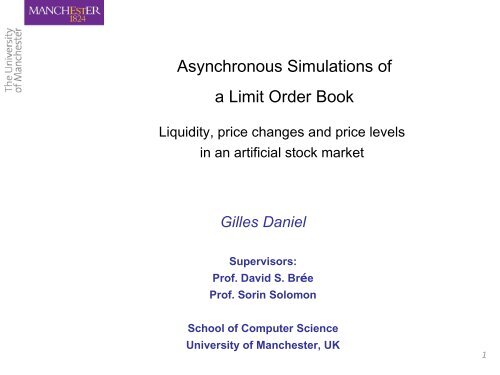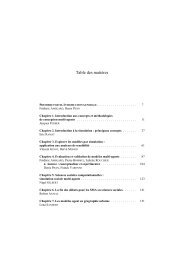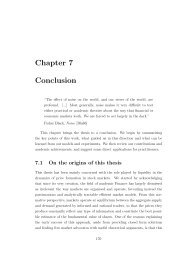Asynchronous Simulations of a Limit Order Book - Gilles Daniel
Asynchronous Simulations of a Limit Order Book - Gilles Daniel
Asynchronous Simulations of a Limit Order Book - Gilles Daniel
You also want an ePaper? Increase the reach of your titles
YUMPU automatically turns print PDFs into web optimized ePapers that Google loves.
<strong>Asynchronous</strong> <strong>Simulations</strong> <strong>of</strong><br />
a <strong>Limit</strong> <strong>Order</strong> <strong>Book</strong><br />
Liquidity, price changes and price levels<br />
in an artificial stock market<br />
<strong>Gilles</strong> <strong>Daniel</strong><br />
Supervisors:<br />
Pr<strong>of</strong>. David S. Brée<br />
Pr<strong>of</strong>. Sorin Solomon<br />
School <strong>of</strong> Computer Science<br />
University <strong>of</strong> Manchester, UK<br />
1
Overview<br />
(hypo)thesis<br />
Liquidity dynamics drive price dynamics and set<br />
equilibrium price levels endogenously<br />
modus operandi<br />
Computer simulations <strong>of</strong>:<br />
- the double auction market mechanism<br />
- the artificial agents responsible for the order flow<br />
.. calibrated on empirical stylised facts<br />
2
Conditions for efficient allocation <strong>of</strong> capital<br />
Informational efficiency<br />
• Market prices must send accurate signals to drive capital into the<br />
productive economy<br />
Liquidity<br />
• Quoted prices must be tradable (liquidity gives stocks there value)<br />
• In the absence <strong>of</strong> news, we expect prices to be stable and continuous<br />
otherwise investors would not bring there capital in the first place<br />
3
Research Questions<br />
What moves stock prices<br />
• Origins <strong>of</strong> the stylised facts observed at intra-day, daily, etc. level<br />
• H0: traders' strategies Or rather the market microstructure<br />
• We go down to the basic, atomic interactions: trades<br />
• We find that high-frequency stylised facts can be recovered with a<br />
disequilibrium model <strong>of</strong> Zero-Intelligence agents, and explained by<br />
uninformed demand shifts<br />
What sets price levels<br />
• H0: Information only Or rather endogenous factors<br />
• Do prices converge to, and reflect, a fund. value (EMH)<br />
• Yes if this fundamental value is common knowledge<br />
• Otherwise, conventions can emerge and get destabilised<br />
endogenously (SRMH)<br />
4
What moves stock prices<br />
5
Stylised Facts (AOL dataset)<br />
Price<br />
Normalised returns<br />
Normality plot<br />
Inter-trade waiting times<br />
6
Stylised Facts (2)<br />
P(r)<br />
P(R>r)<br />
ACF(r)<br />
ACF(|r|)<br />
7
Agent-based Model <strong>of</strong> Price Formation<br />
8
<strong>Limit</strong> <strong>Order</strong> <strong>Book</strong><br />
9
<strong>Asynchronous</strong> Processes<br />
10
Zero-Intelligence Agents<br />
<strong>Order</strong> sign<br />
sign = buy with prob. 0.5<br />
sell with prob. 0.5<br />
<strong>Order</strong> type<br />
type =<br />
<strong>Order</strong> size<br />
cancellation with prob. c<br />
market<br />
limit<br />
v = [v(b)|v(a)]<br />
P(log v) ~ ()<br />
with prob. m<br />
with prob. 1- c<br />
- m<br />
for market orders<br />
for limit orders<br />
<strong>Limit</strong> Price<br />
P(p) ~ U]b,a[<br />
P() ~ -(1+<br />
with prob. in<br />
with prob. 1- in<br />
11
Simulation Runs<br />
12
Aggregate <strong>Order</strong> Flow received<br />
<strong>Limit</strong> price <strong>Limit</strong> price >0<br />
<strong>Order</strong> size<br />
Inter-orders waiting times<br />
13
Spread<br />
Spread s<br />
P(S>s)<br />
14
<strong>Book</strong> shape<br />
Bids<br />
Offers<br />
15
Price dynamics<br />
Price<br />
Normalised returns<br />
<strong>Order</strong> size<br />
Inter-trades waiting times<br />
16
Price Dynamics (2)<br />
P(r)<br />
P(|R|>r)<br />
ACF(r)<br />
ACF(|r|)<br />
17
Conclusion on ZI model<br />
A simple model <strong>of</strong> artificial stock market<br />
implementing a double auction and<br />
populated with ZI agents can reproduce<br />
empirical stylised facts, with no need for<br />
information.<br />
The key is in the subtle interplay<br />
between limit orders, which provide<br />
liquidity, and market and cancellation<br />
orders, which remove it.<br />
18
What sets price levels<br />
19
EMH setup: common knowledge<br />
fundamental value<br />
Price<br />
Zoom<br />
20
With common knowledge fundamental<br />
value (2)<br />
Shares<br />
Cash<br />
Wealth<br />
21
With common knowledge fundamental<br />
value (3)<br />
Wealth ratio<br />
Uninformed traders are not driven out <strong>of</strong> the market<br />
22
With common knowledge fundamental<br />
value (4)<br />
Wealth uninformed<br />
Wealth arbitrageurs<br />
Wealth ratio<br />
23
Conclusion on EMH setup<br />
When the fundamental value is common<br />
knowledge, the EMH holds (the market<br />
price prices converges toward its f.v.),<br />
but uninformed traders are not<br />
necessarily driven out <strong>of</strong> the market by<br />
arbitrageurs.<br />
24
Self-Referential Market Hypothesis<br />
“Prices reflect the beliefs <strong>of</strong> those operating in the<br />
markets – no more, no less.” A. Orléan<br />
Keynes' Beauty Contest<br />
levels <strong>of</strong> specularity<br />
Salient points a la Schelling<br />
volume v -> v*<br />
Conventions (objective and strategic rationalities)<br />
confidence c -> c*<br />
volatility<br />
-> * (learned)<br />
25
Without common knowledge f.v.<br />
Prices<br />
Normalised returns<br />
Measured volatility<br />
Confidence<br />
26
Conclusion on SRMH setup<br />
When the fundamental value is not<br />
common knowledge, it becomes rational<br />
to take into account other traders'<br />
opinion, which leads to the emergence,<br />
stabilisation and collapse <strong>of</strong> conventions,<br />
even in the absence <strong>of</strong> information and<br />
communication, <strong>of</strong>ten interpreted a<br />
posteriori as reflecting an economic<br />
reality.<br />
27
Main message<br />
Liquidity dynamics are not only<br />
responsible for the statistical properties<br />
<strong>of</strong> prices changes (stylised facts), but<br />
they also play a key role in determining<br />
the level at which market prices stabilise<br />
(endogenous conventions).<br />
28
Consequence<br />
The need for liquidity has superseded<br />
the need for sending relevant signals<br />
(informational efficiency) to the<br />
Economy.<br />
29
Contributions<br />
Attract the attention <strong>of</strong> the scientific<br />
community on the relevance <strong>of</strong><br />
modelling the market microstructure.<br />
Propose a disequilibrium model <strong>of</strong> price<br />
formation:<br />
- micr<strong>of</strong>ounded<br />
- endogenous<br />
- consistent with empirical data<br />
30
ACKNOWLEDGEMENTS<br />
David S. Brée<br />
Sorin Solomon<br />
Enrico Scalas<br />
Lev Muchnik<br />
Teams in Manchester and Torino<br />
31







